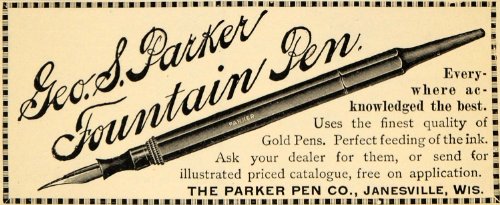
Parker Pens: A Beginning
George S. Parker
The who and the what of the Parker family can get confusing, but for all intents and purposes George S. Parker’s first U.S. patent was issued in 1889 — it was for a pen feed. A pen feed is the apparatus that draws ink from the back of the pen into the nib, which is different from it’s predecessor: the standard fountain pen. This original fountain pen functioned as we see in movies, where someone dips the dip in an inkwell. Parker’s pen feed made for an early version of what we see today.
Prior to this patent, Parker had been a telegraphy teacher and had been selling John Holland fountain pens on the side. As a result, this pen feed patent is quite similar to the pen feeds used in these John Holland pens.
At this time in America, Life Insurance Companies also doubled as venture capital firms and investors. Parker began making his rounds to various life insurers asking for an investment and eventually found interest in a man named W. F. Palmer. There are numerous tellings of this fateful meeting, but whatever the circumstance, W.F. Palmer eventually acquired a full 50% interest in the Parker Pen Company.
The Parker Pen Company became legally incorporated on in 1892 with George S. Parker and W. F. Palmer as its shareholders. During the early days of the business, Parker functioned as ‘Mr. Outside’, that is, as the company’s sales force. Palmer was ‘Mr. Inside’ and managed the firm’s finances and manufacturing. The men were friends and partners and continued to work together for some time. Later in their partnership they executed a similar transaction when they sold Century Pens.
Over the course of the following years, Parker continued to lockdown patents and the primary shift occurred in 1898 when the market began to prefer underfed pens: Parker obliged and they began to cater to their consumers.

